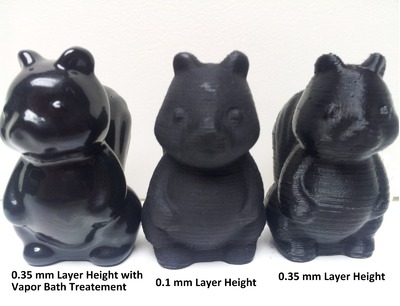After the initial thrill of seeing a 3D print emerge from thin air, 3D print newbies often notice the layering effect. This is, of course, caused by the gradual deposition of plastic layers during the build process. Depending on the layer resolution selected for print, these layers could be very visible, or not.
The point is those visible layers make the 3D printed object’s visual and tactile feel very different from other plastic objects found at the neighborhood store. 3D printer owners are cursed with this problem.
Or are they?
Two solutions have been attempted in the past: tumbling the finished object with specially shaped ceramic bits to slowly rub down the layering, and secondly dipping your ABS plastic print into a tub of acetone.
The tumbling solution works, but requires a tumbler and the correct tumbling media. We found some at a supply shop, but the minimum order was 800 pounds. Not something anyone would care to do. The acetone solution is better, but if done improperly you can severely damage your print or yourself: acetone is a corrosive and flammable nasty substance. We’ve used it as a solvent to clean fused ABS off of damaged extruder parts.
Neil Underwood, an experimenter at RepRap, has found another way to apply acetone to the layering problem: vapor treatment. He’s devised an incredibly inexpensive process to completely smooth your print in 5-10 minutes.
A glass jar containing 3-4mm of acetone is placed on your heated print bed. It is warmed to around +90C by the print bed, causing some of the acetone to vaporize. Fortunately, the rather dangerous vapor stays in the jar because it’s heavier than surrounding air. Your print is safely lowered into the vapor jar and simply sits there, exposed to the acetone vapor for as many minutes as necessary to achieve a smooth, injection-molded-like finish.
We think this is a must for those wanting super-finished ABS parts, as it is easy and inexpensive to do. However: you must have a heated bed, print in ABS and definitely need to have more than adequate ventilation in your work area. We would do this outdoors, if at all possible.
Via RepRap


